Vallisneria Gigantea, also known as Giant Vallisneria, is a breathtaking aquatic plant species that forms magnificent underwater forests in freshwater aquariums. Its long, slender leaves and graceful appearance make it a favorite choice for aquarists looking to create an enchanting underwater landscape.
In this article, we will dive into the world of Eelgrass, exploring its natural habitat, physical characteristics, light and temperature requirements, water conditions, substrate preferences, planting options, recommended tank size, suitable tank mates, nutrition requirements, plant maintenance tips, cultivating the plant at home, propagating techniques, and the benefits of incorporating Vallisneria Gigantea into your aquarium.
By the end of this comprehensive guide, you will deeply understand how to cultivate a flourishing underwater forest with Vallisneria Gigantea, bringing beauty and serenity to your freshwater aquarium.
Key Takeaway
- Vallisneria Gigantea is a stunning freshwater aquarium plant that forms majestic underwater forests.
- It features long, slender leaves and is favored for its graceful appearance.
- Vallisneria Gigantea requires moderate to high light levels and a temperature range of 68-82°F (20-28°C) for optimal growth.
- The plant thrives in slightly alkaline to slightly acidic water conditions with a pH range of 6.5 to 7.5.
- Providing a nutrient-rich substrate and regular plant maintenance are essential for the plant’s health and vitality.
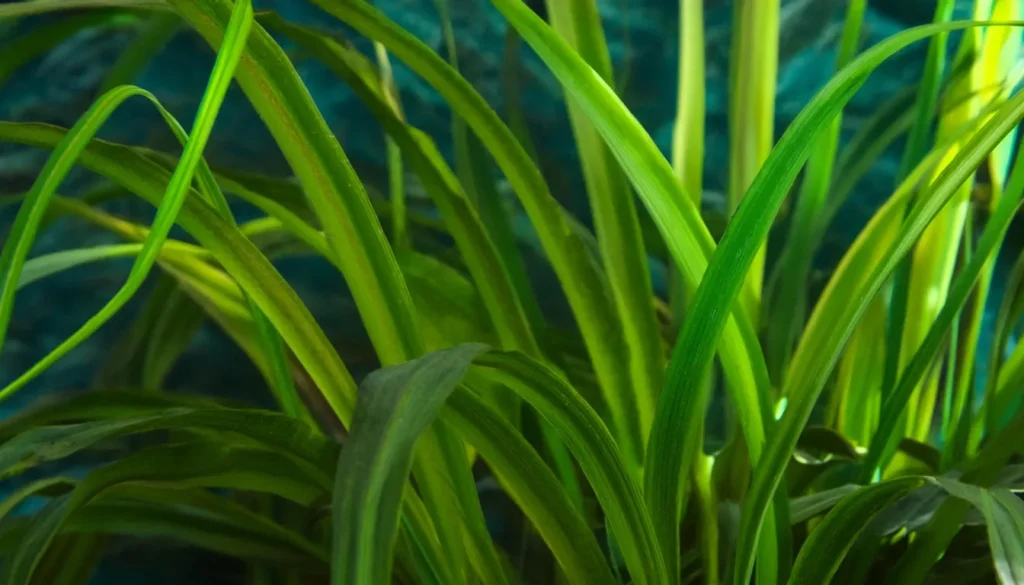
Quick Stats
| Attribute | Details |
| Scientific Name | Vallisneria gigantea |
| Common Name | Giant Vallisneria, Jungle Val |
| Origin | Southeast Asia, Australia, and parts of Africa |
| Height | Up to 2 meters (6.5 feet) or more |
| pH Range | 6.5 – 8.5 |
| CO2 Requirement | Low to Medium |
| Growth Rate | Moderate to Fast |
| Care Level | Easy |
| Color Form | Green |
| Water Conditions | 18-28°C (64-82°F), adaptable to various water parameters |
| Max Size | Can grow to impressive heights in ideal conditions |
| Lighting | Low to High |
| Supplements | Root tabs or liquid fertilizers beneficial |
| Placement | Background |
| Propagation | Through runners or division of rhizome |
What Is Vallisneria Gigantea?
Vallisneria Gigantea is a submerged aquatic plant species that originates from various parts of the world, including North America, Africa, Asia, and Australia. It is commonly found in rivers, ponds, and lakes with slow-moving or still water. Tape grass features long, slender leaves that can reach up to several feet in length, making it an excellent background plant in aquariums. It is popular for freshwater aquarium enthusiasts due to its beautiful appearance and ease of care.
RELATED: Unraveling The Underwater Elegance Of Vallisneria Neotropical
Natural Habitat And Origin
- Vallisneria Gigantea is naturally found in various regions around the world, including North America, Africa, Asia, and Australia. It is often found in freshwater habitats such as rivers, ponds, and lakes with slow-moving or still water. This plant is well adapted to thrive in these environments, with its long, narrow leaves reaching towards the surface to absorb maximum sunlight.
- In aquariums, replicating the natural habitat and growing conditions of Eelgrass is crucial for its optimal growth and development. By providing the right water parameters, substrate, and lighting, you can create an environment that simulates the natural habitat of this stunning aquatic plant. This will promote its overall health, enhance its beauty, and create a visually captivating underwater forest in your aquarium.
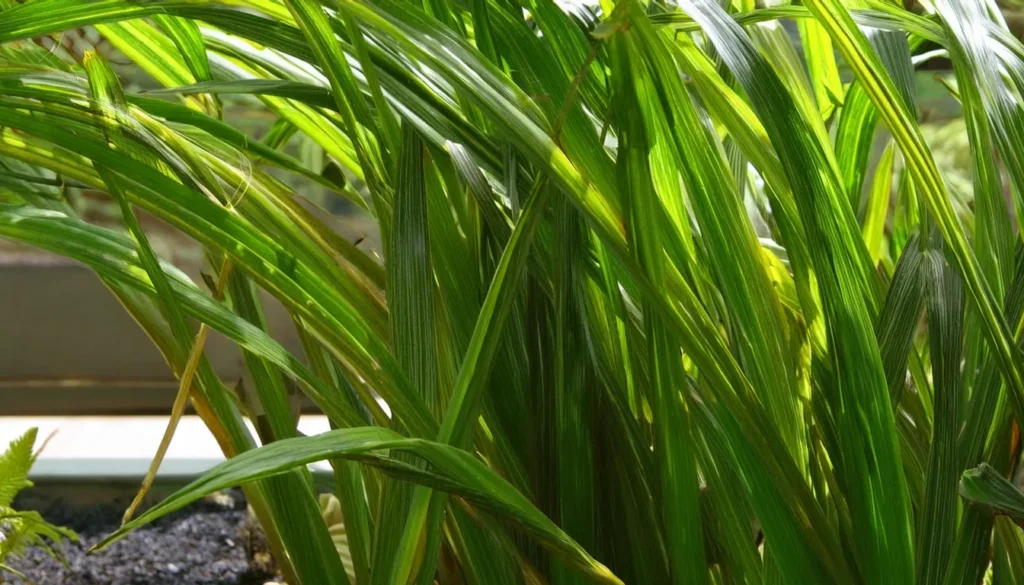
Physical Characteristics Of Vallisneria Gigantea
- Vallisneria Gigantea, also known as Giant Vallisneria, exhibits distinct physical characteristics that make it a captivating addition to any aquarium. One of its most notable features is its long, ribbon-like leaves that can grow up to several feet in length. These leaves are typically light green in color, adding a touch of vibrancy to the aquarium environment. With their narrow, lanceolate shape, the leaves create an elegant and graceful appearance.
- In addition to its long leaves, Vallisneria Gigantea also produces runners, which enable the plant to propagate and spread across the aquarium. These runners give rise to new plantlets that can be separated and replanted, allowing for the expansion of the Vallisneria Gigantea population within the tank. This natural spreading adds to the lushness of the underwater forest created by this remarkable plant.
- It’s worth noting that Vallisneria Gigantea is a dioecious plant, meaning it has separate male and female flowers on different plants. The female flowers are typically held above the water surface, while the male flowers remain submerged. This unique reproductive characteristic further adds to the visual interest and complexity of tape grass.
Light Requirements For Vallisneria Gigantea
Vallisneria Gigantea, like all aquarium plants, has specific light requirements to thrive and maintain optimum health. As a light-loving plant, Vallisneria Gigantea requires moderate to high levels of light for photosynthesis, a vital process for its growth and nutrient uptake. Providing the plant with a suitable light source is crucial to ensure its well-being and overall development.
- It is recommended that Vallisneria Gigantea receive 10-12 hours of light per day. This ensures that the plant receives adequate light energy for photosynthesis. LED lights are a popular choice among aquarists for aquariums containing eelgrass. These lights offer a balanced spectrum of light, mimicking natural sunlight, and are energy-efficient.
- LED lights provide the necessary intensity and color temperature to fulfill the light requirements of Vallisneria Gigantea. They promote healthy growth, vibrant coloration, and proper nutrient absorption in the plant. Additionally, LED lights have a longer lifespan and consume less electricity compared to traditional fluorescent or incandescent lighting options.
- When setting up the lighting for your aquarium, it is crucial to consider the specific needs of Vallisneria Gigantea and the requirements of other aquatic organisms in the tank. Achieving a balance between suitable light intensity and duration will help create a healthy environment for your Vallisneria Gigantea and ensure the success of your overall aquascape.
| Benefits of LED Lights for Vallisneria Gigantea | Drawbacks of LED Lights |
| Energy-efficientLonger lifespanBalanced spectrum for optimal growthEnhanced colorationPromotes photosynthesis and nutrient uptake | Higher initial cost compared to traditional lightingMay require additional accessories for controlling light intensity |
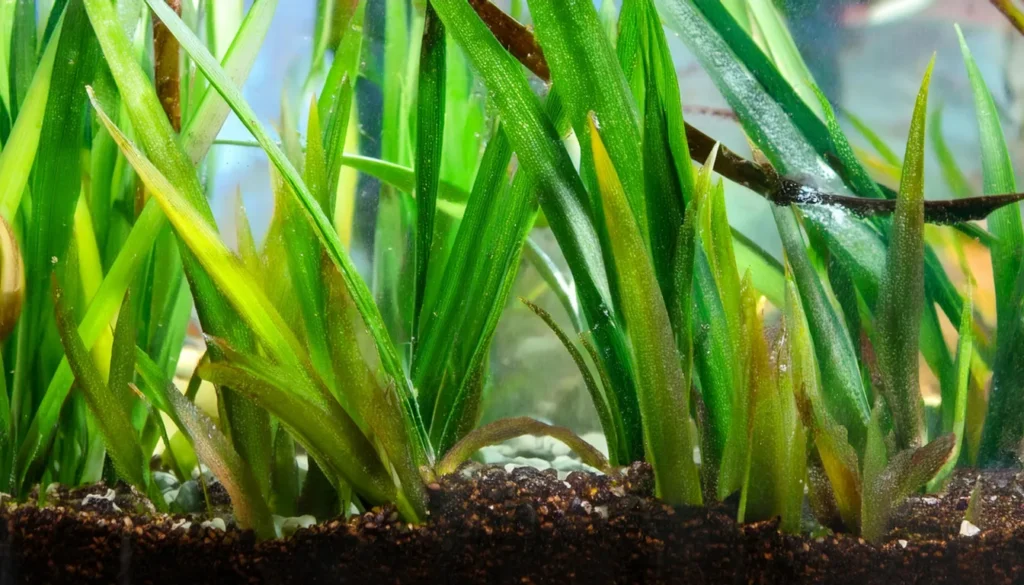
Temperature Parameters For Robust Growth
- Vallisneria Gigantea is a versatile freshwater aquarium plant that can tolerate a wide range of temperatures. However, maintaining a stable temperature within a specific range is crucial for its health and robust growth. The optimal temperature range for Vallisneria Gigantea is between 68-82°F (20-28°C). Within this range, the plant thrives and exhibits its best growth potential.
- To ensure the temperature remains within the desired parameters, it is recommended to use a reliable heater in the aquarium. The heater helps regulate the water temperature, creating a stable environment for eelgrass. Monitoring the temperature regularly and making adjustments as needed will contribute to the plant’s overall well-being.
- In addition to temperature, proper lighting, water conditions, and substrate choices also play essential roles in creating an ideal environment for Vallisneria Gigantea. By carefully maintaining these parameters, you can ensure the plant’s health and enjoy its vibrant presence in your aquarium.
Optimal Water Condition For Vallisneria Gigantea
- Like all aquarium plants, Vallisneria Gigantea relies on clean and well-maintained water conditions for its health and growth. To ensure the optimal water conditions for This Plant, various factors such as pH levels, ammonia and nitrite levels, and nitrate levels must be considered.
- The ideal pH range for Vallisneria Gigantea is slightly alkaline to slightly acidic, with a range of 6.5-7.5. This pH range closely mimics the natural habitat of the plant and promotes its overall well-being. Regular monitoring of the pH level and making adjustments, if necessary, will help create the ideal environment for eelgrass.
- Ammonia and nitrite levels should be kept at or near zero. Elevated levels of these compounds can be harmful to the plant and may indicate a problem with water quality. It is important to test the water regularly and take appropriate measures to address any issues that arise.
- Nitrate levels should be below 20 ppm (parts per million) to ensure the health of Vallisneria Gigantea. Although some nitrate is essential for plant growth, excessive levels can lead to nutrient imbalances and promote algae growth. Regular water changes and the use of a reliable filtration system are essential for maintaining proper nitrate levels in the aquarium.
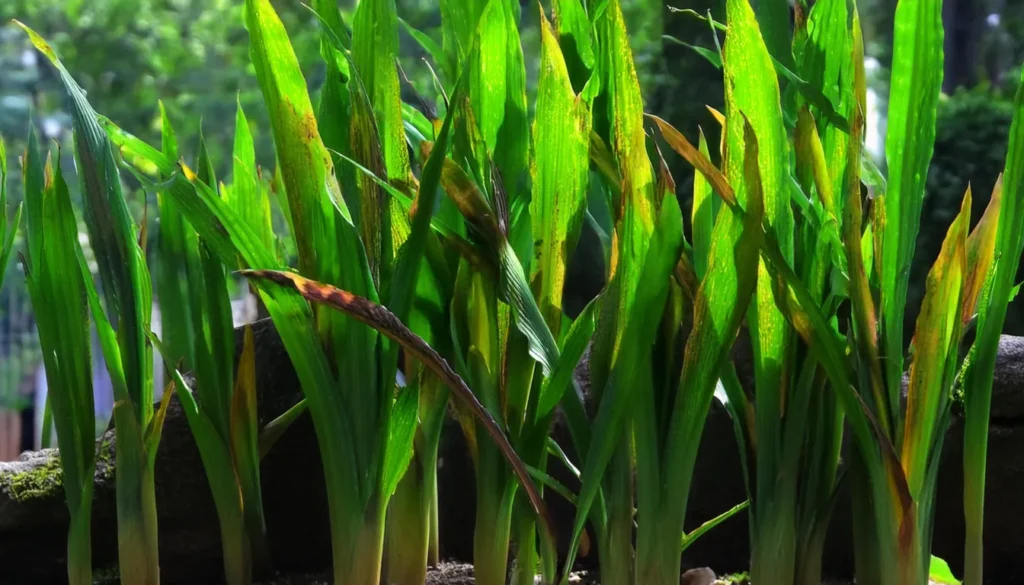
Substrate Requirement
- Vallisneria Gigantea, being a nutrient-hungry plant, requires a substrate that is rich in essential nutrients to support its optimal growth and development. We recommend using a mixture of nutrient-rich soil, clay, and sand as your aquarium substrate for eelgrass. This type of substrate provides a steady supply of nutrients to the plant’s roots, ensuring healthy and vigorous growth.
- In addition to the base substrate, Vallisneria Gigantea can benefit from the use of root tabs or liquid fertilizers specifically designed for aquatic plants. These additives can further enhance the nutrient levels in the substrate, providing an extra boost to the plant’s overall health and vitality.
Planting Option
- When it comes to planting eelgrass in your aquarium, there are a few options to consider. The most common method is to plant the individual strands of the plant directly into the substrate. Make sure to space them a few inches apart to allow for growth and spreading.
- Alternatively, you can plant Vallisneria Gigantea in pots or planters filled with substrate and place them in the aquarium. This method offers easier maintenance and removal if needed. When planting, be sure to firmly bury the roots of the plant in the substrate to ensure proper anchoring.
| Planting Method | Description |
| Direct Planting | Plant individual strands directly into the substrate, spacing them apart for growth and spreading. |
| Potted Planting | Plant Vallisneria Gigantea in pots or planters filled with substrate, allowing for easier maintenance and removal. |

Recommended Tank Size
- Vallisneria Gigantea, a popular freshwater aquarium plant, can be grown in aquariums of various sizes. However, it is recommended to have a minimum tank size of 20 gallons to provide enough space for the plant to spread and grow. Larger aquariums offer even more room for this plant to create a magnificent underwater forest.
- When selecting the appropriate tank size for Vallisneria Gigantea, it is important to consider the overall size of the tank and the other inhabitants. Providing ample space will allow the plant to flourish and thrive, creating a stunning visual display in your aquarium.
Suitable Tank Mates For Vallisneria Gigantea
Vallisneria Gigantea is a peaceful and versatile aquarium plant that can be paired with a wide range of fish and invertebrates, creating a harmonious and balanced aquatic environment. Not only does Vallisneria Gigantea provide shelter and shade for small fish and shrimp, but it also serves as a grazing area. This plant creates a natural and thriving habitat by absorbing excess nutrients in the water and releasing oxygen.
RELATED: Vallisneria Nana Care & Growth Guide Essentials For Beginners
When selecting suitable tank mates for the plant, it is essential to consider their compatibility and behavior. Here are some examples of fish and invertebrates that can coexist peacefully with Vallisneria Gigantea in your aquarium:
- Tetras
- Gouramis
- Rasboras
- Corydoras catfish
- Snails
These tank mates are known to thrive in similar water conditions and are compatible with Vallisneria Gigantea. Together, they can create a vibrant and lively underwater community.
| Fish/Invertebrate | Compatibility with Vallisneria Gigantea |
| Tetras | Peaceful schooling fish that do not disturb or uproot the plant |
| Gouramis | Relatively calm fish that can live harmoniously with Vallisneria Gigantea |
| Rasboras | Small, peaceful fish that coexist well with Vallisneria Gigantea |
| Corydoras catfish | Bottom-dwelling fish that do not disturb the plant and clean up the tank |
| Snails | Invertebrates that help keep the tank clean and do not disturb Vallisneria Gigantea |
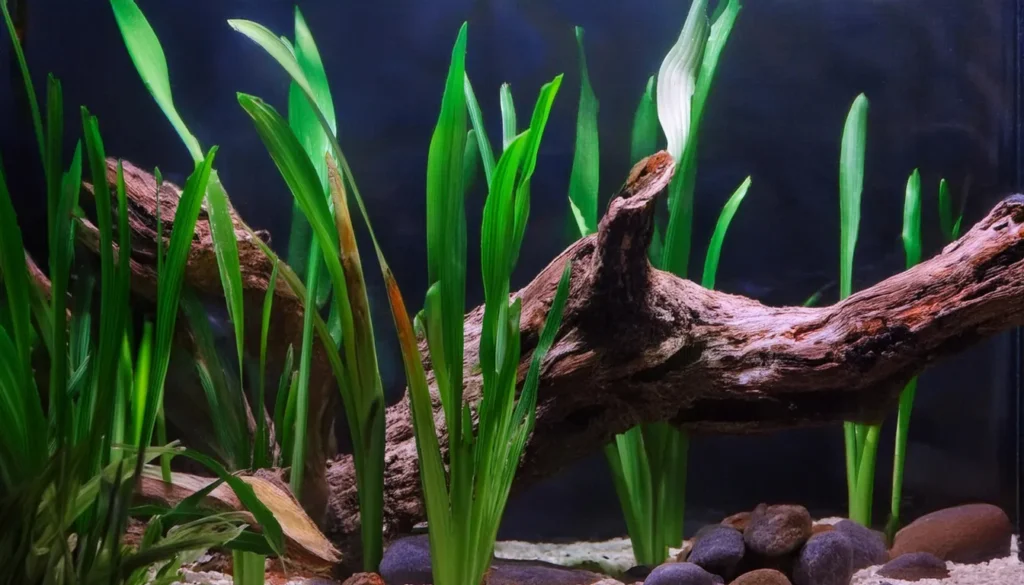
Nutrition Requirements By The Plants
- Vallisneria Gigantea is a nutrient-hungry plant that requires adequate nutrition for healthy growth. It obtains most of its nutrients from the substrate through its roots.
- However, supplementing the plant with a balanced liquid fertilizer specifically formulated for aquatic plants can help ensure it receives all the necessary nutrients. A high-quality liquid fertilizer provides a comprehensive blend of essential macro and micronutrients that promote optimal growth, vibrant coloration, and overall plant health.
- When choosing a liquid fertilizer, look for one that is specifically designed for aquarium plants and contains a balanced ratio of nitrogen (N), phosphorus (P), and potassium (K), as well as trace elements such as iron (Fe), magnesium (Mg), and calcium (Ca). These nutrients are crucial for the plant’s metabolic processes, photosynthesis, and overall vitality.
- It is important to follow the dosage instructions provided by the fertilizer manufacturer to avoid nutrient imbalances or overdosing. Overfertilization can lead to algae problems and other negative effects on water quality. Regular water testing and monitoring of nutrient levels can help ensure the proper balance of nutrients in your aquarium.
| Nutrient | Role | Source |
| Nitrogen (N) | Essential for growth and chlorophyll production | Fertilizer, fish waste, decaying organic matter |
| Phosphorus (P) | Required for energy transfer and root development | Fertilizer, fish waste, decaying organic matter |
| Potassium (K) | Helps with osmoregulation and overall plant health | Fertilizer, fish waste, decaying organic matter |
| Iron (Fe) | Essential for chlorophyll synthesis and overall plant metabolism | Fertilizer, substrate, water column supplements |
| Magnesium (Mg) | Required for chlorophyll production and enzyme activation | Fertilizer, substrate, water column supplements |
| Calcium (Ca) | Essential for cell wall structure and overall plant integrity | Fertilizer, substrate, water column supplements |
Plant Maintenance Tips
- Maintaining Vallisneria Gigantea is essential for ensuring its long-term health and vitality in your aquarium. Following a few simple plant maintenance tips can keep your plant looking beautiful and thriving.
- Regular pruning is necessary to maintain the overall aesthetic appeal of the plant. Remove any yellow or decaying leaves to keep the plant looking vibrant and healthy. This will also prevent the spread of any potential diseases or pests that may affect the plant or other aquarium inhabitants. Trimming the tips of the leaves can also promote bushier growth and prevent the plant from overshadowing other aquarium plants or inhabitants.
- Monitoring and maintaining proper water conditions is crucial for the growth and well-being of Vallisneria Gigantea. Ensure that the water temperature, pH, and nutrient levels are suitable for the plant’s requirements. Regularly test and adjust the water parameters to maintain optimal conditions. Proper lighting is also essential for the plant’s photosynthesis process, so ensure that it receives adequate light for its growth.
Cultivating Plant At Home
- Light Intensity: Provide moderate to high light levels, as Vallisneria Gigantea is a light-loving plant. Aim for 10-12 hours of light per day. LED lights are recommended for aquariums, as they offer a balanced light spectrum and energy efficiency.
- Temperature: Maintain a temperature range of 68-82°F (20-28°C) in the aquarium. Keep in mind that Vallisneria Gigantea prefers slightly warm water but can tolerate a range of temperatures.
- Water Conditions: Ensure clean and well-maintained water conditions. Maintain a pH range of 6.5-7.5, with ammonia and nitrite levels at or near zero and nitrate levels below 20 ppm. Regular water changes and a reliable filtration system are crucial.
- Substrate: Use a nutrient-rich substrate composed of a mix of soil, clay, and sand. This type of substrate provides essential nutrients to the plant’s roots and promotes healthy growth.
Propagating Tips
- Propagating Vallisneria Gigantea involves taking advantage of its runners or stolons. These runners produce new plantlets that can be separated from the parent plant and replanted to promote new growth. Once the new plantlets have developed their own root system, they can be gently detached from the runner and planted in the substrate. This allows them to establish themselves as individual plants, contributing to the expansion and diversity of your underwater forest.
- If you prefer a more naturalistic approach, you can leave the runner intact, allowing the new plantlets to spread and create a lush and vibrant aquatic habitat. This method is particularly suitable for larger aquariums or when aiming to achieve a dense underwater forest effect.
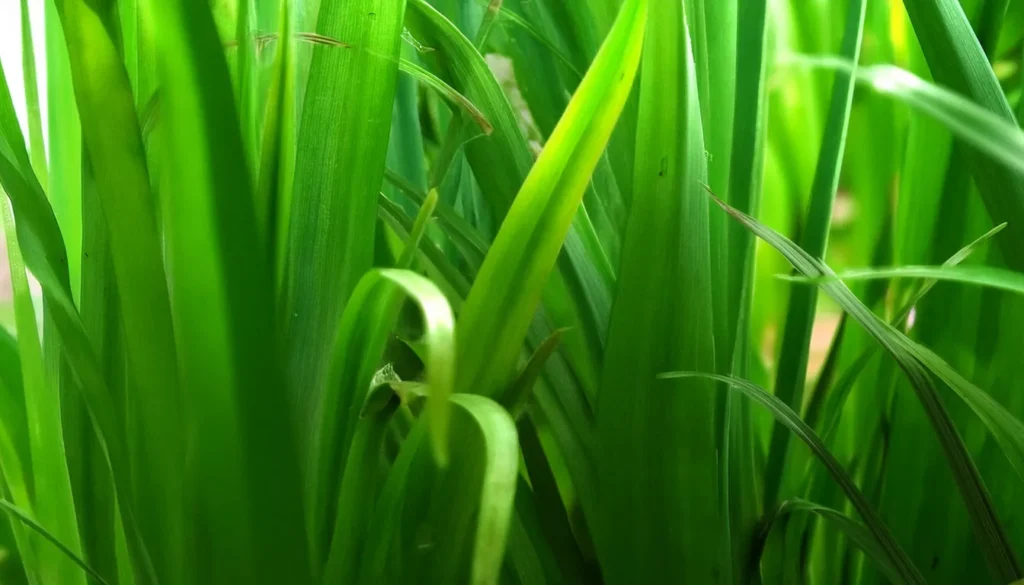
Benefits Of Planting Vallisneria Gigantea
- Planting Vallisneria Gigantea in your aquarium offers numerous benefits. Its long, flowing leaves create a visually striking backdrop and add depth to the aquascape.
- Vallisneria Gigantea also provides valuable shelter, grazing areas, and spawning grounds for fish and invertebrates.
- It contributes to the overall health and balance of the aquarium ecosystem by absorbing excess nutrients and releasing oxygen. Additionally, Vallisneria Gigantea can help prevent algae growth by competing for nutrients and shading the water column.
Conclusion
Vallisneria Gigantea is a stunning freshwater aquarium plant that has the power to transform your tank into a majestic underwater forest. Whether you’re captivated by its physical characteristics, intrigued by its lighting and temperature requirements, or fascinated by its propagation methods, Vallisneria Gigantea offers a wide range of options for creating a lush and vibrant aquascape. By providing the right conditions and proper maintenance, you can enjoy the beauty and benefits of this remarkable plant in your own aquarium.
Vallisneria Gigantea is not just a visually appealing plant; it also plays a crucial role in the overall health and balance of your aquarium. Acting as a natural shelter, grazing area, and spawning ground for fish and invertebrates, Vallisneria Gigantea contributes to the well-being of your aquatic ecosystem. With its ability to absorb excess nutrients and release oxygen, this plant can help prevent algae growth and create a harmonious environment for all inhabitants.
RELATED: Vallisneria Nana Care & Growth Guide Essentials For Beginners
Frequently Asked Questions
What Are The Nutrition Requirements For Vallisneria Gigantea?
Vallisneria Gigantea obtains most of its nutrients from the substrate through its roots. Supplementing the plant with a balanced liquid fertilizer specifically formulated for aquatic plants can ensure it receives all the necessary nutrients.
How Do I Maintain Vallisneria Gigantea?
Regular pruning of yellow or decaying leaves is necessary to maintain the plant’s aesthetic appeal. Trimming the tips of the leaves can promote bushier growth and prevent overshadowing. Monitoring and maintaining proper water conditions are crucial for the plant’s growth.
How Can I Cultivate Vallisneria Gigantea At Home?
To cultivate Vallisneria Gigantea at home, create a suitable environment by providing the appropriate light intensity, temperature, water conditions, and substrate. Regular maintenance, proper feeding, and plant health monitoring are essential for successful cultivation.
How Can I Propagate Vallisneria Gigantea?
Vallisneria Gigantea can be propagated through its runners or stolons. These runners produce new plantlets that can be separated from the parent plant and replanted. Once the new plantlets have developed their own root system, they can be detached from the runner and planted in the substrate.
What Are The Benefits Of Planting Vallisneria Gigantea In My Aquarium?
Planting Vallisneria Gigantea in your aquarium enhances the visual appeal by creating a majestic underwater forest. It provides valuable shelter, grazing areas, and spawning grounds for fish and invertebrates. It also contributes to the overall health and balance of the aquarium ecosystem.
- Unveiling The Wonders Of Riccia Fluitans In Aquascapes - August 7, 2024
- Vallisneria Gigantea Var. Guide To Care And Cultivation At Home - July 31, 2024
- Vesicularia Dubyana Care & Growth Guide Tips For Beginner Gardeners - July 30, 2024
